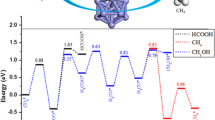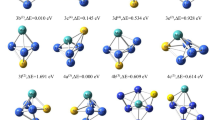Abstract
Context
Hydrogen has emerged as a promising clean energy carrier, underscoring the imperative need to comprehend its adsorption mechanisms. This study delves into the magnetic and electronic properties of Co-Mo-P clusters, aiming to unveil their catalytic potential in hydrogen production. Employing density functional theory (DFT), we optimized cluster configurations and scrutinized their magnetic behaviors. Our investigation unveiled 16 stable configurations of the ConMoP (n = 1 ~ 5) cluster, predominantly in steric forms. The magnetic attributes were primarily ascribed to the d orbitals of Co metal atoms, with Co3MoP exhibiting exceptional magnetic characteristics. Analysis of density of state diagrams revealed the prevalence of spin-up α-electrons in d orbitals, while spin-down β-electrons attenuated overall magnetic properties. Localized orbital (LOL) analysis highlighted stable covalent bonds within the clusters, affirming their catalytic potential. Orbital delocalization index (ODI) analysis revealed diverse spatial distribution ranges for orbitals across different configurations, suggesting a progressive attenuation of off-domain properties with increasing cluster size. Furthermore, infrared spectroscopy unveiled distinct vibrational peaks in various configurations, indicative of unique infrared activities. These findings contribute to a nuanced theoretical understanding of Co-Mo-P clusters and pave the path for future research aimed at augmenting their catalytic efficiency in hydrogen production. This study underscores the viability of Co-Mo-P clusters as alternatives to conventional Pt catalysts, offering insights into the design of novel materials for sustainable energy applications. Further research is warranted to explore the behavior of the Co-Mo-P system under diverse reaction conditions, fostering advancements in materials and energy science.
Methods
In this study, we harnessed the ConMoP (n = 1 ~ 5) cluster as a simulation platform for probing the local structure of the material. Our aim was to scrutinize the magnetism, electronic characteristics influenced by the varying metal atoms within these clusters. A systematic exploration involved incrementing the number of metal atoms and expanding the cluster size to elucidate the corresponding property variations. Density functional theory (DFT) calculations were pivotal to our methodology, employing the B3LYP hybrid functional implemented in the Gaussian 16 software package. The ConMoP (n = 1 ~ 5) cluster underwent optimization calculations and vibrational analysis at the def2-tzvp quantization level, yielding optimized configurations with diverse spin multiplet degrees. To comprehensively characterize and visually represent the stability, electronic features, and catalytic attributes of these configurations, we employed a suite of computational tools. Specifically, quantum chemistry software GaussView and wave function analysis software Multiwfn played integral roles. Through the integrated use of these computational tools, we acquired valuable insights into the magnetism, electronic characteristics of the ConMoP (n = 1 ~ 5) cluster, shedding light on their dependency on distinct metal atoms.









Similar content being viewed by others
Data availability
Data sharing not applicable to this article as no datasets were generated or analyzed during the current study.
References
Xu H, Zhao L, Liu X, Li D, Xia Q, Cao X, Zhang J (2021) CoMoP2 nanoparticles anchored on N, P doped carbon nanosheets for high-performance lithium-oxygen batteries. FlatChem 25:100221
Lv X, Hu Z, Ren J, Liu Y, Wang Z, Yuan ZY (2019) Self-supported Al-doped cobalt phosphide nanosheets grown on three-dimensional Ni foam for highly efficient water reduction and oxidation. Inorg Chem Front 6(1):74–81
Zhang Y, Jin Z, Su Y, Wang G (2019) Charge separation and electron transfer routes modulated with Co-Mo-P over g-C3N4 photocatalyst. Mol Catal 462:46–55
Wu TH, Fang ZG, Wang ZY, Song J, Song JL, Liu LE (2023) The stable polarizability of cluster Co2Mo2P3 structure. J Jiangxi Normal University (Natural Science) 47(02):148–153
Fang ZG, Xu Y, Wang ZY, Mao ZL, Zheng XX, Zeng XY, Wu TH (2022) The study on hydrogen evolution reaction of cluster Co4P amorphous alloy based on quantum chemistry. J Jiangxi Normal University (Natural Science) 46(3):221–226
Zheng XX, Fang ZG, Qin Y, Hou QQ, Wu TH, Mao ZL (2021) Electronic properties of Fe3Ni3 cluster. J Guizhou University (Natural Science) 38(05):7–12+9
Zl M, Fang ZG, Hou QQ, Wang Q, Xu Y, Song JL (2022) The predictive analysis of cluster Co3FeP spectra. J Jiangxi Normal University (Natural Science) 46(1):81–86
Zhang T, Yang TX, Li B, Wei SH, Gao W (2022) Enhancing the electrochemical hydrogen evolution of CoP3/CoMoP nanosheets through the support of black TiO2−x nanotube arrays. J Alloy Compd 905:164165
Zhang TT, Wang YH, Yuan JH, Fang KM, Wang AJ (2022) Heterostructured CoP-CoMoP nanocages as advanced electrocatalysts for efficient hydrogen evolution over a wide pH range. J Colloid Interface Sci 615:465–474
Wei YP, Li W, Li DZ, Yi LY, Hu WH (2022) Amorphous-crystalline cobalt-molybdenum bimetallic phosphide heterostructured nanosheets as Janus electrocatalyst for efficient water splitting. Int J Hydrogen Energy 47(12):7783–7792
Wang X, Yang LL, Xing CC, Han X, Du RF, He R, Cabot A (2022) MOF-derived ultrathin cobalt molybdenum phosphide nanosheets for efficient electrochemical overall water splitting. Nanomaterials 12(7):1098
Zhang Y, Shao Q, Long S, Huang XQ (2018) Cobalt-molybdenum nanosheet arrays as highly efficient and stable earth-abundant electrocatalysts for overall water splitting. Nano Energy 45:448–455
Zhang YM, Liu LY, Zhao LL, Hou CX, Huang MN, Algadi HS, Liu Y (2022) Sandwich-like CoMoP2/MoP heterostructures coupling N, P co-doped carbon nanosheets as advanced anodes for high-performance lithium-ion batteries. Adv Compos Hybrid Mater 5(3):2601–2610
Ma YY, Wu CX, Feng XJ, Tan HQ, Yan LK, Liu Y, Li YG (2017) Highly efficient hydrogen evolution from seawater by a low-cost and stable CoMoP@C electrocatalyst superior to Pt/C. Energy Environ Sci 10(3):788–798
Lin Y, Liu M, Pan Y, Zhang J (2017) Porous Co-Mo phosphide nanotubes: an efficient electrocatalyst for hydrogen evolution. J Mater Sci 52(17):10406–10417
Wang DZ, Zhang XY, Zhang DZ, Shen YL, Wu ZZ (2016) Influence of Mo/P ratio on CoMoP nanoparticles as highly efficient HER catalysts. Appl Catal A 511:11–15
Mai WS, Cui Q, Zhang ZQ, Zhang KK, Li GQ, Tian LH, Hu W (2020) CoMoP/NiFe-layered double-hydroxide hierarchical nanosheet arrays standing on Ni foam for efficient overall water splitting. ACS Appl Energy Mater 3(8):8075–8085
Alonso JA (2000) Electronic and atomic structure, and magnetism of transition-metal clusters. Chem Rev 100(2):637–678
Qin Y, Fang ZG, Zhang W, Li LH, Liao W (2020) The study on the catalytic properties of cluster Co3NiB in the hydrogen evolution reaction. J Jiangxi Normal University (Natural Science) 44(01):56–62
Fang ZG, Wang ZY, Zheng XX, Qin Y, Mao ZL, Zeng XY, Zhu YW, Wang Q (2022) Study on the dolarizability, dipole moment and density of states of cluster Co3NiB2. J Guizhou University (Natural Sciences) 39(01):17–24
Li D, Liu D, Zhao S, Lu S, Ma Y, Li M, Xiao C (2019) Tuning of metallic valence in CoMoP for promoting electrocatalytic hydrogen evolution. Int J Hydrogen Energy 44(59):31072–31081
Thenuwara AC, Dheer L, Attanayake NH, Yan QM, Waghmare UV, Strongin DR (2018) Co-Mo-P based electrocatalyst for superior reactivity in the alkaline hydrogen evolution reaction. ChemCatChem 10(21):4832–4837
Gong L, Lan K, Wang X, Huang XK, Jiang PB, Wang KZ, Yang M, Ma L, Li R (2020) Carbon-coated Co-Mo-P nanosheets supported on carbon cloth as efficient electrocatalyst for hydrogen evolution reaction. Int J Hydrogen Energy 45(01):544–552
Luo SC, Nie D, Li Z, Sun XY, Hu L, Liu XY (2020) Effects of carboxylic acid auxiliary ligands on the magnetic properties of azido-Cu (II) complexes: a density functional theory study. Polyhedron 182:114506
Du JB, Feng ZF, Zhang Q, Han LJ, Tang YL, Li QF (2019) Molecular structure and electronic spectrum of MoS2 under external electric field. Acta Physica Sinica 68(17)
Kargar H, Behjatmanesh-Ardakani R, Torabi V, Kashani M, Chavoshpour-Natanzi Z, Kazemi Z, Mirkhani V, Sahraei A, TahirMN AM, Munawar KS (2021) Synthesis characterization crystal structures DFT TD-DFT molecular docking and DNA binding studies of novel copper (II) and zinc (II) complexes bearing halogenated bidentate N O-donor Schif base ligands. Polhedron 195:114988
Gaussian 16, Revision A.03, MJ Frisch, GW Trucks, HB Schlegel, GE Scuseria, MA Robb, JR Cheeseman, G Scalmani, V Barone, GA Petersson, H Nakatsuji, X Li, M Caricato, AV Marenich, J Bloino, BG Janesko, R Gomperts, B Mennucci, HP Hratchian, JV Ortiz, AF Izmaylov, JL Sonnenberg, D Williams-Young, F Ding, F Lipparini, F Egidi, J Goings, B Peng, A Petrone, T Henderson, D Ranasinghe, VG Zakrzewski, J Gao, N Rega, G Zheng, W Liang, M Hada, M Ehara, K Toyota, R Fukuda, J Hasegawa, M Ishida, T Nakajima, Y Honda, O Kitao, H Nakai, T Vreven, K Throssell, JA Montgomery Jr, JE Peralta, F Ogliaro, MJ Bearpark, JJ Heyd, EN Brothers, KN Kudin, VN Staroverov, TA Keith, R Kobayashi, J Normand, K Raghavachari, AP Rendell, JC Burant, SS Iyengar, J Tomasi, M Cossi, JM Millam, M Klene, C Adamo, R Cammi, JW Ochterski, RL Martin, K Morokuma, O Farkas, JB Foresman, DJ Fox, Gaussian, Inc., Wallingford CT 2016
Lu T, Chen QX (2021) Interaction region indicator: a simple real space function clearly revealing both chemical bonds and weak interactions. Chem-Methods 1(5):231–239
Fang ZG, Liu LE, Wu TH, Song JL, Yuan L, Wei DX (2024) Spectral analysis of cluster CrPS4 based on density functional theory. J Guizhou Normal University (Natural Science Edition) 42(3):1–7
Li LH, Fang ZG, Zhao ZN, Qin Y (2019) Study of Ni3CoP electronic properties and magnetism. J Jiangxi Normal University (Natural Science Edition) 43(02):160–166
Acknowledgements
Thanks to the National Natural Science Foundation of China and the National Student Innovation and Entrepreneurship Training Program for funding
Funding
This work was supported by the National Natural Science Foundation of China Key Project (51634004) and National Student Innovation and Entrepreneurship Training Program (202310146025, 202310146026, 202310146027, 202210146008, 202110146027).
Author information
Authors and Affiliations
Contributions
T-H W contributed to writing, data management, and methodology. Z-G F contributed to conceptualization and project management. L-E L contributed to article proofreading. J-L S contributed to verification and methodology. J S contributed to proofreading the article.
Corresponding author
Ethics declarations
Competing interests
The authors declare no competing interests.
Additional information
Publisher's Note
Springer Nature remains neutral with regard to jurisdictional claims in published maps and institutional affiliations.
Rights and permissions
Springer Nature or its licensor (e.g. a society or other partner) holds exclusive rights to this article under a publishing agreement with the author(s) or other rightsholder(s); author self-archiving of the accepted manuscript version of this article is solely governed by the terms of such publishing agreement and applicable law.
About this article
Cite this article
Wu, T., Fang, Z., Song, J. et al. Magnetism and electronic properties of ConMoP (n = 1 ~ 5) cluster: a DFT study. J Mol Model 30, 142 (2024). https://doi.org/10.1007/s00894-024-05938-9
Received:
Accepted:
Published:
DOI: https://doi.org/10.1007/s00894-024-05938-9




